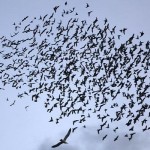 Nature provides us with some of the most spectacular examples of herd behavior, with collectives seemingly capable of rapidly responding to stimuli, even without a single ‘leader’ seeming to control or coordinate their behavior.
Nature provides us with some of the most spectacular examples of herd behavior, with collectives seemingly capable of rapidly responding to stimuli, even without a single ‘leader’ seeming to control or coordinate their behavior.
It’s a degree of agility that most human organizations could only dream of. How do these flocks and herds manage to response so swiftly in nature?
A recent study, published in the Proceedings of the Royal Society, attempts to shed some light on the matter.
The paper explores how the signal produced by the animal closest to a particular threat spreads so rapidly throughout the group. The researchers used optimal control theory to produce mathematical models that capture the imitative behavior of the group.
“The nearly-in-unison movement of a herd of animals away from danger may be the result of rapid transfer of information in a collective,” the authors say. “An individual close to danger senses it and signals avoidance to others through an action such as turning. Signals need to propagate, and in this case, the flock itself is the medium through which such information spreads in a wave of activity arising from an optimality principle.”
How information flows
Normally when models are made of flock behavior, it’s imagined that each animal is an individual agent with a large amount of free will to go as they please based upon their perceptions of the environment.
Analysis conducted for the paper of starlings in flight explored the way information flowed through the flock, especially in terms of the optimal control of the flock.
“We have already used optimal control principles in solving inverse problems such as reconstructing smooth trajectories from sampled data of natural flocks,” the authors say. “We expect insights from optimal control could yield testable predictions on information transfer in some flocking events. This is work in progress.”
What are the practical implications of this you may ask? The authors believe that their findings could be used for shaping collective behavior in robotics to allow them to work more effectively together.
It would appear unlikely however for the findings to work their way into how human organizations function, at least for the time being.